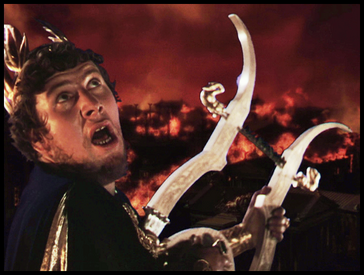Overview[]
Sword and sandal films were at one time one of the biggest Hollywood draw. Quo Vadis in 1951, Ben Hur in 1959, Spartacus in 1960, and Cleopatra in 1963 were each among the highest grossing films in their respective years. Due to this popularity and potential for massive monetary returns, studios and filmmakers pushed the available technology and film techniques to their limits, or even developed new techniques and technologies. The four aforementioned films each display this phenomenon, each advancing the art of filmmaking, each in their own ways.
Quo Vadis[]

Directed by Mervyn LeRoy, Quo Vadis follows Marcus Vinicius who is played by Robert Taylor. Marcus falls in love with a slave woman named Lydia played by Deborah, who is a Christian in a time where Christians were being persecuted by the Roman emperor Nero, portrayed by Peter Ustinov. This film is heavily embellished with Christian iconography, themes and narrative. Quo Vadis' contribution to cinematic advancement is its willingness to use an exuberant amount of money on a few particular scenes. The great fire that burns down part of Rome that Nero starts towards the end of the film reported cost one hundred thousand dollars in 1950's money which was an insane amount of money at the time. This scene was expensive due to LeRoy "assembling a 1/12th scale model of the city inside a 300 square-foot tank. While three hundred alcohol burners destroyed the model eighteen gasoline burners sent flares twenty feet in the air" (Cyrino 2005, 21).
Ben Hur[]

Ben Hur is the story of Judah Ben Hur, portrayed by Charlton Heston, and his quest for revenge against his childhood friend Messala who is played by Stephen Boyd. Messala imprisons Ben Hur, as well as Ben Hur's mother and sister, Miriam and Tirzah respectively, for a tile falling off of their roof and spooking the horse that the new governor of Judea is riding. Ben Hur has the biggest budget of any film made up to this point. Ben Hur's contribution to the advancement of film is in two areas, the use of 65mm cameras, and the vehicles used to film the chariot race scene. The 65mm film allowed for widescreen, higher clarity and quality, as well as a smoother less granulated picture (Cyrino 2005, 74). The vehicles used to film the chariot race were specifically developed for shooting this scene. These cars allowed cameras to stay alongside chariots in order to get closer shots of the actors faces while they were riding. This technology was eventally used in other genres and films for exciting sequences.
Spartacus[]

Spartacus, directed by Stanley Kubrick, follows the titular hero played by Kirk Douglas who is forced to fight in gladiatorial fights due to his uncooperative nature. He eventually brings forth a rebellion led by slaves against the Romans called the Servile Wars. Spartacus is eventually crucified at the end of the movie, but has some relief on his dying moments in seeing his baby son for the first time and knowing that he isn't going to grow up and have to be a slave or gladiator like Spartacus. Spartacus advances the sword and sandal genre by being one of the first to focus on mostly secular ideas and conflicts, one of the first to leave out an abundance of religious themes, at least until the end of the movie. This film advanced film as a whole by actively rebelling against the Red Ban at the time. Stanley Kubrick hired Dalton Trumbo, who was one of the "Hollywood Ten". After his involvement in the McCarthy trials, his first couple of films that he wrote were done so under pseudonyms due to the blacklisting that occurred. Kubrick had Trumbo actually credited using his real name for his work.
Cleopatra[]

Cleopatra stars Elizabeth Taylor as the titular character. Cleopatra is the smart, beautiful, and charming sister of the Pharaoh Ptolemy. Caesar comes to Egypt to find someone whom he defeated in battle, only to be smitten by Cleopatra. Caesar is sieged by Cleopatras brother, which leads Caesar to burn the Egyptian fleet, which spread to the city. Cleopatras biggest contribution to the film world is the creation of the paparazzi and the actors ad drama that occurs in the background film being as important as the film itself. Elizabeth Taylor was one of the biggest stars of the time and was married, but it was rumored that she and Richard Burton who played Mark Antony, had and intense affair throughout the production. This lead to people taking pictures of the stars and them being sold to news sources, the paparrazi. This is still occuring today, maybe even more often due to the general population having camera phones.
Conclusion[]
Due to the sword and sandal genres high potential, many advances were made in the film industry, some for the better such as the technology developed for Ben Hur, or possibly for the worse, such as the creation of the paparazzi for Cleopatra. Either way, the sword and sandal film genre will go down as one of the most influential film genre.